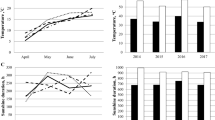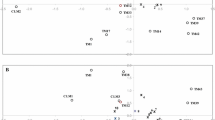Abstract
Little is known about the essential oil content and yield, and physiological and morphological traits of Thymus species including Thymus fedtschenkoi, Thymus kotschyanus, Thymus migricus, and Thymus transcaucasicus. This is the first report on the presence and absence of Thymus species influenced by elevation, precipitation, and temperature. Therefore, the objectives of this study were to investigate the effects of geographical and environmental parameters and species variations on plant growth, quality, and the presence or absence of Thymus populations of Iran. The plants of four different Thymus species were collected at the full flowering stage over 2017 and 2018 from different provinces of Iran. Presence-only modeling method called Maxent was used to predict geographic distributions of species. The impact of climate variability on the qualitative and quantitative properties of populations was higher than the soil physical and chemical characteristics. Temperature was the most important factor that influenced the presence of Thymus species, followed by elevation and precipitation (for T. kotschyanus, the importance of precipitation was greater than elevation). Thymus species are most common in cool to moderate annual temperatures that are elevated enough. Mean total flavonoid in 2018 was higher than that in 2017 across populations due to drought stress. Averaged across locations and years, essential oil yield was in the order of T. kotschyanus > T. migricus > T. fedtschenkoi > T. transcaucasicus. Carvacrol was the main component of T. migricus essential oil from Yam. T. migricus essential oil from Kechi-gala and all populations from T. kotschyanus, T. fedtschenkoi, and T. transcaucasicus had thymol as the main component. The selection of desirable suitable areas and genotypes for cultivation of plants is the first step due to a great effect on the quality and quantity of production.





Similar content being viewed by others
References
Akcin TA (2006) Numerical taxonomic studies on some species of the genus Thymus L.(Labiatae) in Turkey. Asian J Plant Sci 5:782–788
Adams RP (2001) Identification of essential oil components by gas chromatography/mass spectroscopy. Allured Publishing Corporation, Carol Stream, IL, USA
Aminkhani A, Sharifi R, Ranjbar E, Chalabian F, Katouzian F (2019) Antimicrobial activities and chemical constituents of essential oil extracted from stem, leaf, and flower of Thymus fedtschenkoi from Khoy, Iran. J Food Process Preserv 43:e14149
Amiri H (2012) Essential oils composition and antioxidant properties of three Thymus species. Evid-Based Compl Alt Medicine 2012:728065
Arsenijević J, Drobac M, Šoštarić I, Jevđović R, Živković J, Ražić S, Moravčević Đ, Maksimović Z (2019) Comparison of essential oils and hydromethanol extracts of cultivated and wild growing Thymus pannonicus All. Ind Crop Prod 130:162–169
Basiri MH, Nadjafi F (2019) Effect of plant density on growth, yield and essential oil characteristics of Iranian Tarragon (Artemisia dracunculus L.) landraces. Sci Hortic 257:108655
Bigdeloo M, Hadian J, Nazeri V (2017) Composition of essential oil compounds from different populations of Thymus caramanicus Jalas. Appl Res Med Aromatic Plants 7:95–98
Bistgani ZE, Hashemi M, DaCosta M, Craker L, Maggi F, Morshedloo MR (2019) Effect of salinity stress on the physiological characteristics, phenolic compounds and antioxidant activity of Thymus vulgaris L. and Thymus daenensis Celak. Ind Crop Prod 135:311–320
Delazar A, Bahmani M, Shoar HH, Tabatabaei-Raisi A, Asnaashari S, Nahar L, Sarker SD (2011) Effect of altitude, temperature and soil on essential oil production in Thymus fedtschenkoi flowers in Osko and surrounding areas in Iran. J Essent Oil Bear Plants 14:23–29
European Pharmacopoeia (2008) Directorate for the quality of medicines and healthcare of the Council of Europe (EDQM), Strasbourg, France. sixth ed., vol. 1
Fereidoonfar H, Salehi-Arjmand H, Khadivi A, Akramian M (2018) Morphological variability of sumac (Rhus coriaria L.) germplasm using multivariate analysis. Ind Crop Prod 120:162–170
Ghasemi Pirbalouti A, Emami Bistghani Z, Malekpoor F (2015) An overview on genus Thymus. J Herbal Drugs 6:93–100
Ghelichnia H (2016) Essential oil composition of three species of Thymus growing wild in mazandaran, Iran. Cercetari Agronomice in Moldova 49:107–113
Gholami Takaloo S, Hassani A, Hassanpouraghdam MB, Meshkatalsadat MH, Pirzad A, Heidari M (2012) Essential oil content and composition of Thymus migricus Klokov & Desj-Shost. affected by plant growth stage and wild habitat altitude. Rom Biotechnol Lett 17:6983–6988
Golkar P, Mosavat N, Jalali SAH (2020) Essential oils, chemical constituents, antioxidant, antibacterial and in vitro cytotoxic activity of different Thymus species and Zataria multiflora collected from Iran. S Afr J Bot 130:250–258
Hemmingmoore H, Aronsson M, Åkesson M, Persson J, Andrén H (2020) Evaluating habitat suitability and connectivity for a recolonizing large carnivore. Biol Conserv 242:108352
Javadi H, Hesamzadeh Hejazi SM, Babayev MS (2009) Karyotypic Studies of three Thymus (Lamiaceae) species and populations in Iran. Caryologia 62:316–325
Jie ZOU, Wei HU, Li YX, He JQ, Zhu HH, Zhou ZG (2020) Screening of drought resistance indices and evaluation of drought resistance in cotton (Gossypium hirsutum L.). J Integr Agric 19(2):495–508
Khanahmadi F, Rahimmalek M, Sabzalian MR, Tohidi B (2021) Variation of essential oil content and composition, phenolics, and yield related traits using different pollination systems in populations of Thymus species. Chem Biodivers 18(6):e2100097
Khorshidi J, Rasouli M, Rustaiee AR, Mohamadparast B (2014) Chemical composition of the essential oil of Thymus fedtschenkoi growing wild in Iran. J Essent Oil Bear Plants 17:173–175
Lajayer HM, Zakizadeh H, Hamidoghli Y, Bigluei MH, Chamani E (2018) Ornamental potential and freezing tolerance of six Thymus spp. species as ground-covering plants in the landscape. Zemdirbyste-Agriculture 105:79–88
Llorens L, Llorens-Molina JA, Agnello S, Boira H (2014) Geographical and environment-related variations of essential oils in isolated populations of Thymus richardii Pers. in the Mediterranean basin. Biochem Syst Ecol 56:246–254
Mahboubi M, Heidarytabar R, Mahdizadeh E, Hosseini H (2017) Antimicrobial activity and chemical composition of Thymus species and Zataria multiflora essential oils. Agric Nat Resour 51(5):395–401
Manukyan A (2019) Secondary metabolites and their antioxidant capacity of Caucasian endemic thyme (Thymus transcaucasicus Ronn.) as affected by environmental stress. J Appl Res Med Aromatic Plants 13:100209
Mehalaine S, Chenchouni H (2019) Effect of climatic factors on essential oil accumulation in two lamiaceae species from algerian semiarid lands. In: Exploring the Nexus of Geoecology, Geography, Geoarcheology and Geotourism (pp. 57-60) Springer, Cham
Mehalaine S, Chenchouni H (2020) Plants of the same place do not have the same metabolic pace: soil properties affect differently essential oil yields of plants growing wild in semiarid Mediterranean lands. Arab J Geosci 13(23):1263
Mehalaine S, Chenchouni H (2021) Quantifying how climatic factors influence essential oil yield in wild-growing plants. Arab J Geosci 14(13):1257
Millan M, Rowe NP, Edelin C (2019) Deciphering the growth form variation of the Mediterranean chamaephyte Thymus vulgaris L. using architectural traits and their relations with different habitats. Flora 251:1–10
Mohammadi H, Amirikia F, Ghorbanpour M, Fatehi F, Hashempour H (2019) Salicylic acid induced changes in physiological traits and essential oil constituents in different ecotypes of Thymus kotschyanus and Thymus vulgaris under well-watered and water stress conditions. Ind Crop Prod 129:561–574
Mozaffarian V (1996) A dictionary of Iranian plant names (Latin, English, Persian). Farhang Moaser Publishers, Tehran, Iran, pp 547–548
Nabavi SM, Marchese A, Izadi M, Curti V, Daglia M, Nabavi SF (2015) Plants belonging to the genus Thymus as antibacterial agents: from farm to pharmacy. Food Chem 173:339–347
Nangle EJ, Gardner DS, Metzger JD, Rodriguez-Saona L, Guisti MM, Danneberger TK, Petrella DP (2015) Pigment changes in cool-season turfgrasses in response to ultraviolet-B light irradiance. Agron J 107:41–50
Pavela R, Bartolucci F, Desneux N, Lavoir AV, Canale A, Maggi F, Benelli G (2019) Chemical profiles and insecticidal efficacy of the essential oils from four Thymus taxa growing in central-southern Italy. Ind Crop Prod 138:111460
Phillips SJ, Dudík M (2008) Modeling of species distributions with Maxent: new extensions and a comprehensive evaluation. Ecography 3:161–175
Rustaiee AR, Yavari A, Nazeri V, Shokrpour M, Sefidkon F, Rasouli M (2013) Genetic diversity and chemical polymorphism of some Thymus species. Chem Biodivers 10:1088–1098
Senoussi A, Schadt I, Hioun S, Chenchouni H, Saoudi Z, Aissaoui Zitoun Hamama O, Zidoune MN, Carpino S, Rapisarda T (2021) Botanical composition and aroma compounds of semi-arid pastures in Algeria. Grass Forage Sci 76(2):282–299
Shayganfar A, Azizi M, Rasouli M (2018) Various strategies elicited and modulated by elevated UV-B radiation and protectant compounds in Thymus species: differences in response over treatments, acclimation and interaction. Ind Crop Prod 113:298–307
Tandon HLS (Ed.), (1995) Methods of analysis of soils, plants, waters and fertilisers. Fertilisers Development and Consultation Organisation, New Delhi, India
Tohidi B, Rahimmalek M, Arzani A (2017) Essential oil composition, total phenolic, flavonoid contents, and antioxidant activity of Thymus species collected from different regions of Iran. Food Chem 220:153–161
Tohidi B, Rahimmalek M, Trindade H (2019) Review on essential oil, extracts composition, molecular and phytochemical properties of Thymus species in Iran. Ind Crop Prod 134:89–99
Tohidi B, Rahimmalek M, Arzani A, Sabzalian MR (2020) Thymol, carvacrol, and antioxidant accumulation in Thymus species in response to different light spectra emitted by light-emitting diodes. Food Chem 307:125521
Vaičiulytė V, Butkienė R, Ložienė K (2016) Effects of meteorological conditions and plant growth stage on the accumulation of carvacrol and its precursors in Thymus pulegioides. Phytochemistry 128:20–26
Wiese N, Fischer J, Heidler J, Lewkowski O, Degenhardt J, Erler S (2018) The terpenes of leaves, pollen, and nectar of thyme (Thymus vulgaris) inhibit growth of bee disease-associated microbes. Sci Rep 8:1–12
Yousefzadeh S, Daryai F, Mokhtassi-Bidgoli A, Hazrati S, Yousefzadeh T, Mohammadi K (2018) Morphological, essential oil and biochemical variation of Dracocephalum moldavica L. populations. J Appl Res Med Aromatic Plants 10:59–66
Zouaoui N, Chenchouni H, Bouguerra A, Massouras T, Barkat M (2020) Characterization of volatile organic compounds from six aromatic and medicinal plant species growing wild in North African drylands. NFS Journal 18:19–28
Funding
The current paper is extracted from research project entitled “Effect of environmental factors on the distribution of Thymus species in different habitats of Iran” which was financial supported by Research Grant from Payame Noor University, Tehran, Iran.
Author information
Authors and Affiliations
Corresponding author
Ethics declarations
Conflict of interest
The authors declare that they have no competing interests.
Additional information
Responsible editor: Haroun Chenchouni
Rights and permissions
About this article
Cite this article
Yousefzadeh, S., Abedi, R. & Mokhtassi-Bidgoli, A. Which environmental factors are more important for geographic distributions of Thymus species and their physio-morphological and phytochemical variations?. Arab J Geosci 14, 1864 (2021). https://doi.org/10.1007/s12517-021-08253-2
Received:
Accepted:
Published:
DOI: https://doi.org/10.1007/s12517-021-08253-2




